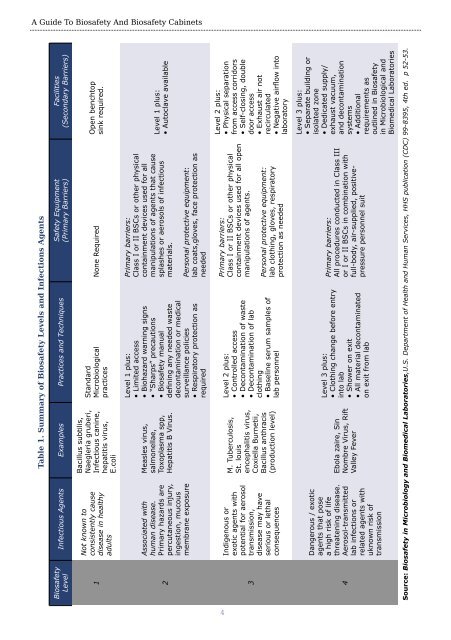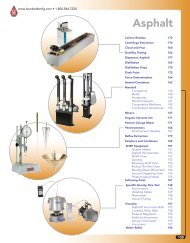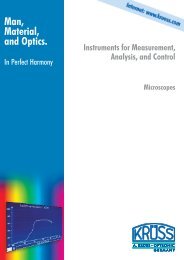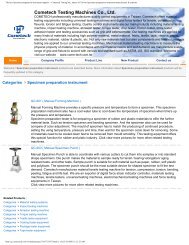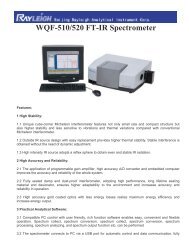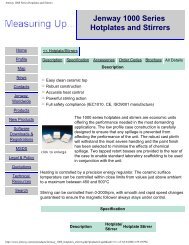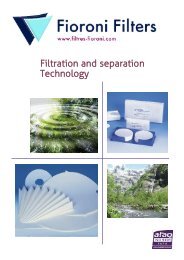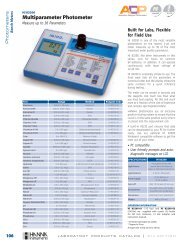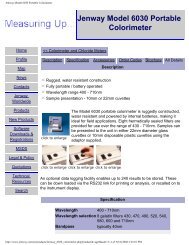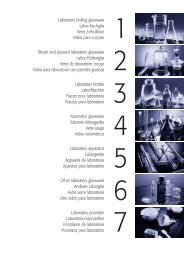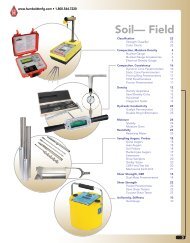Esco Labculture® Plus Class II Type A2 Biosafety Cabinet - Comlibris
Esco Labculture® Plus Class II Type A2 Biosafety Cabinet - Comlibris
Esco Labculture® Plus Class II Type A2 Biosafety Cabinet - Comlibris
You also want an ePaper? Increase the reach of your titles
YUMPU automatically turns print PDFs into web optimized ePapers that Google loves.
A Guide To <strong>Biosafety</strong> And <strong>Biosafety</strong> <strong>Cabinet</strong>s<br />
Table 1. Summary of <strong>Biosafety</strong> Levels and Infections Agents<br />
Facilities<br />
(Secondary Barriers)<br />
Safety Equipment<br />
(Primary Barriers)<br />
Infectious Agents Examples Practices and Techniques<br />
<strong>Biosafety</strong><br />
Level<br />
Open benchtop<br />
sink required.<br />
None Required<br />
Standard<br />
Microbiological<br />
practices<br />
Bacillus subtilis,<br />
Naegleria gruberi,<br />
Infectious canine,<br />
hepatitis virus,<br />
E.coli<br />
Not known to<br />
consistently cause<br />
disease in healthy<br />
adults<br />
1<br />
Level 1 plus:<br />
• Autoclave available<br />
Primary barriers:<br />
<strong>Class</strong> I or <strong>II</strong> BSCs or other physical<br />
containment devices used for all<br />
manipulations of agents that cause<br />
splashes or aerosols of infectious<br />
materials.<br />
Level 1 plus:<br />
• Limited access<br />
• Biohazard warning signs<br />
• “Sharps” precautions<br />
• <strong>Biosafety</strong> manual<br />
defining any needed waste<br />
decontamination or medical<br />
surveillance policies<br />
• Respiratory protection as<br />
required<br />
Measles virus,<br />
salmonellae,<br />
Toxoplasma spp,<br />
Hepatitis B Virus.<br />
Associated with<br />
human disease.<br />
Primary hazards are<br />
percutaneous injury,<br />
ingestion, mucous<br />
membrane exposure<br />
2<br />
Personal protective equipment:<br />
lab coats,gloves, face protection as<br />
needed<br />
Level 2 plus:<br />
• Physical separation<br />
from access corridors<br />
• Self-closing, double<br />
door access<br />
• Exhaust air not<br />
recirculated<br />
• Negative airflow into<br />
laboratory<br />
Primary barriers:<br />
<strong>Class</strong> I or <strong>II</strong> BSCs or other physical<br />
containment devices used for all open<br />
manipulations of agents.<br />
Level 2 plus:<br />
• Controlled access<br />
• Decontamination of waste<br />
• Decontamination of lab<br />
clothing<br />
• Baseline serum samples of<br />
lab personnel<br />
Indigenous or<br />
exotic agents with<br />
potential for aerosol<br />
transmission,<br />
disease may have<br />
serious or lethal<br />
consequences<br />
4<br />
M. Tuberculosis,<br />
St. louis<br />
encephalitis virus,<br />
Coxiella Burnetii,<br />
Bacillus anthracis<br />
(production level)<br />
3<br />
Personal protective equipment:<br />
lab clothing, gloves, respiratory<br />
protection as needed<br />
Level 3 plus:<br />
• Separate building or<br />
isolated zone<br />
• Dedicated supply/<br />
exhaust vacuum,<br />
and decontamination<br />
systems<br />
• Additional<br />
requirements as<br />
outlined in <strong>Biosafety</strong><br />
in Microbiological and<br />
Biomedical Laboratories<br />
Primary barriers:<br />
All procedures conducted in <strong>Class</strong> <strong>II</strong>I<br />
or I or <strong>II</strong> BSCs in combination with<br />
full-body, air-supplied, positivepressure<br />
personnel suit<br />
Level 3 plus:<br />
• Clothing change before entry<br />
into lab<br />
• Shower on exit<br />
• All material decontaminated<br />
on exit from lab<br />
Ebola zaire, Sin<br />
Nombre Virus, Rift<br />
Valley Fever<br />
Dangerous / exotic<br />
agents that pose<br />
a high risk of life<br />
threatening disease.<br />
Aerosol-transmitted<br />
lab infections or<br />
related agents with<br />
uknown risk of<br />
transmission<br />
4<br />
Source: <strong>Biosafety</strong> in Microbiology and Biomedical Laboratories,U.S. Department of Health and Human Services, HHS publication (CDC) 99-8395, 4th ed. p 52-53.


